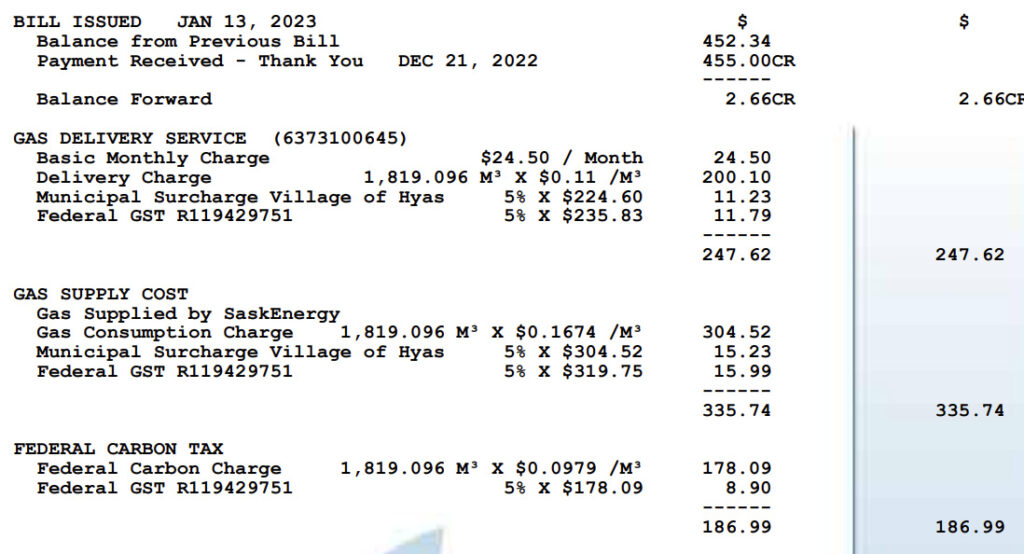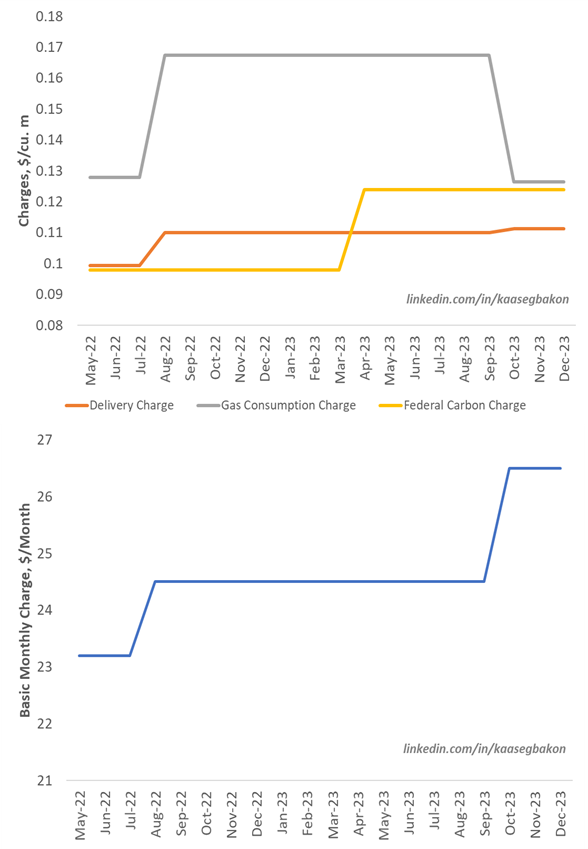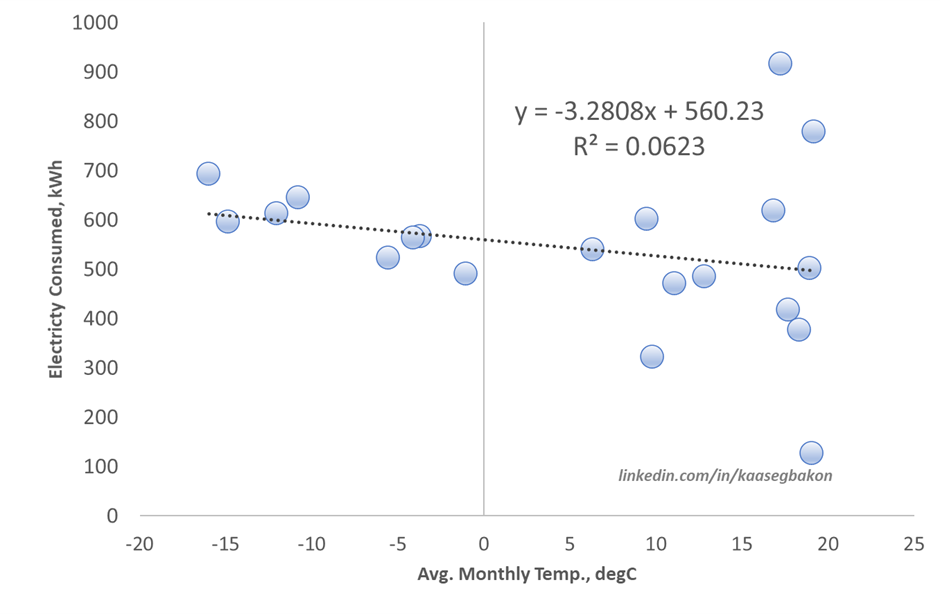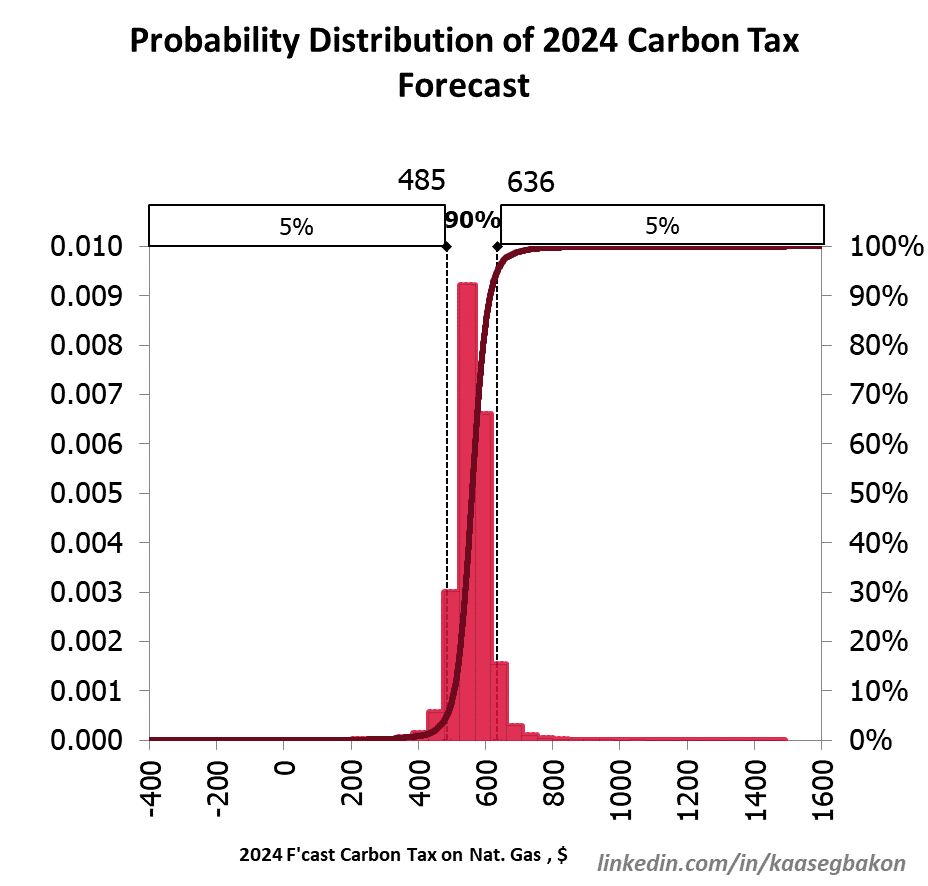An op-ed, short for “opposite the editorial page”, is a written prose piece, which expresses the opinion of an author usually not affiliated with the publication’s editorial board.

This was the carbon tax paid for a house and small shop in Hyas, SK, in January 2023, back when the carbon tax was still $50 a tonne. It will soon be $80 a tonne.
Editor’s Note: Prince Albert-based economist Kaase Gbakon did some hard number crunching on his monthly carbon tax. Here’s his in-depth analysis for his natural gas and power bills. I’m not afraid to admit that some of it is over my head, but then again, I used to dig ditches for a living. Sit down and dig in to this analysis, and you might find some interesting revelations.
By Kaase Gbakon
INTRODUCTION
I live in the prairie province of Saskatchewan – the land of the living skies. In a press release on 28 December 2023, the provincial government announced that starting 1 January 2024, it would suspend the collection of the federal carbon tax on heating from natural gas, and power. The policy will reportedly save an average Saskatchewan household $400 in 2024 on natural gas bills and will reduce the power bills of 30,000 customers dependent on electric heating by an average of $21 per month through the winter. This is according to the press release and as reported here by Brian Zinchuk. This came after the federal government issued a 3-year suspension of carbon taxes on heating oil for the Atlantic provinces.
About this time last year, I wrote a post about my gasoline consumption as part of my reflections on the year that had just gone by, which you can find here. Here I am again, reflecting on my past natural gas and electricity usage.
In this article, I will invite you to join me in exploring the following issues:
- The mechanics behind federal carbon tax calculations
- Impact of temperature on my own natural gas and electricity usage
- Estimate of my savings on the carbon tax on natural gas and electricity use for 2024 following Saskatchewan’s suspension of collection.
Lets dive right in!
- 0106 SASPO-2874_Self Serve Campaign_New Connects_Youtube_v30106 SASPO-2874_Self Serve Campaign_New Connects_Youtube_v3
- 0105 SaskEnergy Commitment to Safety0105 SaskEnergy Commitment to Safety
- 0102 Lori Carr Coal Extended0102 Lori Carr Coal Extended
- 0100 Turnbull Project Manager0100 Turnbull Project Manager
- 0099 Mryglod Steel 1080p0099 Mryglod Steel 1080p
- 0097 Eagle Sky Ventures LTD0097 Eagle Sky Ventures LTD
- 0095 Fast Trucking nearly 70 years good at it0095 Fast Trucking nearly 70 years good at it
- 0092 Turnbull projects big and small0092 Turnbull projects big and small
- 0046 City of Estevan This is Estevan Teaser0046 City of Estevan This is Estevan Teaser
- 0077 Caprice Resources Stand Up For Free Speech0077 Caprice Resources Stand Up For Free Speech
- 0061 SIMSA 2024 For Sask Buy Sask0061 SIMSA 2024 For Sask Buy Sask
- 0051 JML Hiring Pumpjack assembly0051 JML Hiring Pumpjack assembly
- 0049 Scotsburn Dental soft guitar0049 Scotsburn Dental soft guitar
- 0041 DEEP Since 2018 now we are going to build0041 DEEP Since 2018 now we are going to build
- 0032 IWS Summer hiring rock trailer music
- 0022 Grimes winter hiring
- 0021 OSY Rentals S8 Promo
- 0018 IWS Hiring Royal Summer
- 0013 Panther Drilling PO ad 03 top drive rigs
- 0002 gilliss casing services0002 gilliss casing services
- 9002 Pipeline Online 30 sec EBEX9002 Pipeline Online 30 sec EBEX
- 9001
CARBON TAX CALCULATIONS
I turn to my natural gas bill to get a handle on how the federal carbon tax on residential home heating is calculated. SaskEnergy is the single crown corporation enabled by the SaskEnergy Act to supply gas within the province. The utility company has an explainer of the components of the bill it serves customers as seen here. I have also posted a sample of a SaskEnergy utility bill from their website.

Fig. 1: Sample of a SaskEnergy Bill (Rates shown may not be current)
When it comes to electricity, the electric power bills served by SaskPower – the crown corporation responsible for power generation, transmission and supply within the province – also include a federal carbon tax component. I will also look at my SaskPower bill to peel back how the carbon tax is calculated.
In the province, electric heating is relied upon by those without access to natural gas. Hence, the suspension of the carbon tax on electric home heating applies to that population segment. Furthermore, because electricity can be used for purposes other than heating, SaskPower will only reduce the federal carbon tax rate rider on bills by 60 per cent. This is on the consideration that for customers who rely on electric heat, 60 percent of power consumed during winter is for heating.
If you have not paid much attention to these essential elements of your home spending, then I welcome you to spend some time here.
- 0106 SASPO-2874_Self Serve Campaign_New Connects_Youtube_v30106 SASPO-2874_Self Serve Campaign_New Connects_Youtube_v3
- 0105 SaskEnergy Commitment to Safety0105 SaskEnergy Commitment to Safety
- 0102 Lori Carr Coal Extended0102 Lori Carr Coal Extended
- 0100 Turnbull Project Manager0100 Turnbull Project Manager
- 0099 Mryglod Steel 1080p0099 Mryglod Steel 1080p
- 0097 Eagle Sky Ventures LTD0097 Eagle Sky Ventures LTD
- 0095 Fast Trucking nearly 70 years good at it0095 Fast Trucking nearly 70 years good at it
- 0092 Turnbull projects big and small0092 Turnbull projects big and small
- 0046 City of Estevan This is Estevan Teaser0046 City of Estevan This is Estevan Teaser
- 0077 Caprice Resources Stand Up For Free Speech0077 Caprice Resources Stand Up For Free Speech
- 0061 SIMSA 2024 For Sask Buy Sask0061 SIMSA 2024 For Sask Buy Sask
- 0051 JML Hiring Pumpjack assembly0051 JML Hiring Pumpjack assembly
- 0049 Scotsburn Dental soft guitar0049 Scotsburn Dental soft guitar
- 0041 DEEP Since 2018 now we are going to build0041 DEEP Since 2018 now we are going to build
- 0032 IWS Summer hiring rock trailer music
- 0022 Grimes winter hiring
- 0021 OSY Rentals S8 Promo
- 0018 IWS Hiring Royal Summer
- 0013 Panther Drilling PO ad 03 top drive rigs
- 0002 gilliss casing services0002 gilliss casing services
- 9002 Pipeline Online 30 sec EBEX9002 Pipeline Online 30 sec EBEX
- 9001
SaskEnergy Gas Bill
Table one shows the breakdown of how natural gas consumption is billed. The table has been recreated from the components of a typical SaskEnergy utility bill for residential natural gas supply. The bill has five main inputs: The gas usage (in cubic meters) and basic monthly charge (in $); also included are the delivery charge, gas consumption charge, and federal carbon charge (which are all expressed in $ per cubic meter).
The gas usage is read off the gas meter and is established as the difference between the current month’s reading and the prior month’s gas meter reading.

Table 1: Template Describing how SaskEnergy Calculates your gas bill
Other than the customer gas usage, the other four inputs exhibit step changes, as depicted in the figure over the past 20 months.

Fig. 2: Historical Changes in Gas Charges
You can find a historical evolution of these four inputs on SaskEnergy’s website here. However, as of Dec 2023 the charges were: Basic Monthly charge (M=$26.50), Delivery charge (a= $0.1113/m3), Gas consumption charge (b=$0.1264/m3), and federal carbon charge (c=$0.1239/m3)
- 0106 SASPO-2874_Self Serve Campaign_New Connects_Youtube_v30106 SASPO-2874_Self Serve Campaign_New Connects_Youtube_v3
- 0105 SaskEnergy Commitment to Safety0105 SaskEnergy Commitment to Safety
- 0102 Lori Carr Coal Extended0102 Lori Carr Coal Extended
- 0100 Turnbull Project Manager0100 Turnbull Project Manager
- 0099 Mryglod Steel 1080p0099 Mryglod Steel 1080p
- 0097 Eagle Sky Ventures LTD0097 Eagle Sky Ventures LTD
- 0095 Fast Trucking nearly 70 years good at it0095 Fast Trucking nearly 70 years good at it
- 0092 Turnbull projects big and small0092 Turnbull projects big and small
- 0046 City of Estevan This is Estevan Teaser0046 City of Estevan This is Estevan Teaser
- 0077 Caprice Resources Stand Up For Free Speech0077 Caprice Resources Stand Up For Free Speech
- 0061 SIMSA 2024 For Sask Buy Sask0061 SIMSA 2024 For Sask Buy Sask
- 0051 JML Hiring Pumpjack assembly0051 JML Hiring Pumpjack assembly
- 0049 Scotsburn Dental soft guitar0049 Scotsburn Dental soft guitar
- 0041 DEEP Since 2018 now we are going to build0041 DEEP Since 2018 now we are going to build
- 0032 IWS Summer hiring rock trailer music
- 0022 Grimes winter hiring
- 0021 OSY Rentals S8 Promo
- 0018 IWS Hiring Royal Summer
- 0013 Panther Drilling PO ad 03 top drive rigs
- 0002 gilliss casing services0002 gilliss casing services
- 9002 Pipeline Online 30 sec EBEX9002 Pipeline Online 30 sec EBEX
- 9001
I will not repeat the details of the calculation in the bill, except to say that the bill broadly has three major components as follows:
- Gas delivery service,
- Gas supply cost and
- Federal Carbon tax
The sum of these three yields the monthly natural gas bill due captured in the last row of the table.
Focused on the federal carbon tax, represented as “L,” we see that it is driven by the gas usage (G) and the applicable carbon charge – represented as “c.” The carbon charge ordinarily expressed in $/mtCO2eq is converted to $/m3 basis based on considerations of how much CO2eq emissions result from consuming 1m3 of natural gas. The carbon charge is also predictable based on the schedule enshrined by the Canadian federal government in the Greenhouse Gas Pollution Pricing Act.
SaskPower Electricity Bill
Table two captures the breakdown of how residential electricity is billed. Like Table One, this table has been recreated from a typical SaskPower electric bill. The SaskPower bill has four main inputs: the electricity consumed (denoted as “E” in kWh), the unit cost of electricity (denoted as “a” in $/kWh), the federal carbon charge (denoted as “b” in $/kWh) and the basic monthly charge (“M” in $)
The electricity consumed is established as the difference between the current month’s power reading and the prior month’s power meter reading.

Table 2: Template Describing how SaskPower Calculates your gas bill
Other than the electricity usage, the other three inputs exhibit step changes, as depicted in Fig 3 over the last 20 months. As of Dec. 2023, the charges were: Basic Monthly charge (M=$29.99), unit cost of electricity (a= $0.1490/kWh), and federal carbon charge (b=$0.010125/kWh).

Fig. 3: Historical Changes in Electric Charges
As seen in the electric bill calculation depicted in the table, there are broadly three major components as follows:
- Electrical charges (the guys at SaskPower have a sense of humour I see),
- Federal carbon tax and
- Surcharges and taxes
The sum of these three yields the monthly electric power bill due.
Focused on the federal carbon tax, represented in Table 2 as “F,” we see that it is driven by the electricity consumed (“E”) and the applicable carbon charge – represented as “b.” The carbon charge ordinarily expressed in $/mtCO2eq is converted to $/kWh based on considerations of how much CO2eq is emissions arise from consuming 1kWh of electrical energy.
From the assessment of how the utility companies compute the charges, the carbon tax I pay on these two utilities depends on how much natural gas and electricity is consumed at my residence.
- 0106 SASPO-2874_Self Serve Campaign_New Connects_Youtube_v30106 SASPO-2874_Self Serve Campaign_New Connects_Youtube_v3
- 0105 SaskEnergy Commitment to Safety0105 SaskEnergy Commitment to Safety
- 0102 Lori Carr Coal Extended0102 Lori Carr Coal Extended
- 0100 Turnbull Project Manager0100 Turnbull Project Manager
- 0099 Mryglod Steel 1080p0099 Mryglod Steel 1080p
- 0097 Eagle Sky Ventures LTD0097 Eagle Sky Ventures LTD
- 0095 Fast Trucking nearly 70 years good at it0095 Fast Trucking nearly 70 years good at it
- 0092 Turnbull projects big and small0092 Turnbull projects big and small
- 0046 City of Estevan This is Estevan Teaser0046 City of Estevan This is Estevan Teaser
- 0077 Caprice Resources Stand Up For Free Speech0077 Caprice Resources Stand Up For Free Speech
- 0061 SIMSA 2024 For Sask Buy Sask0061 SIMSA 2024 For Sask Buy Sask
- 0051 JML Hiring Pumpjack assembly0051 JML Hiring Pumpjack assembly
- 0049 Scotsburn Dental soft guitar0049 Scotsburn Dental soft guitar
- 0041 DEEP Since 2018 now we are going to build0041 DEEP Since 2018 now we are going to build
- 0032 IWS Summer hiring rock trailer music
- 0022 Grimes winter hiring
- 0021 OSY Rentals S8 Promo
- 0018 IWS Hiring Royal Summer
- 0013 Panther Drilling PO ad 03 top drive rigs
- 0002 gilliss casing services0002 gilliss casing services
- 9002 Pipeline Online 30 sec EBEX 9002 Pipeline Online 30 sec EBEX
- 9001
TWO MODELS FOR THOSE COLD WINTER NIGHTS
Natural gas is used for home heating, and in Saskatchewan, this is especially important in the winter. The province is famed for its very cold winters, so much so that there are jokes around it …like those you can find here. So, it is to be expected that seasonal temperatures will influence gas consumption. The literature also mentions a relationship between temperature and electric power consumption – SaskPower tracks my electricity consumption with temperature. Remember too that SaskPower figures there are some 30,000 households in the province who depend on electric heat to ward off the winter freeze. Surely, their electricity consumption will show some relationship with temperature.
Natural Gas Demand Model
Looking at the 20 months of my gas usage with average monthly temperatures, I find that my monthly natural gas usage in cubic meters increases with decreasing monthly average temperature. This much is seen in Fig 4.

Fig. 4: Gas Consumption Pattern with Temperature in a Home in Saskatchewan
At the start of the series in May 2022, with the average temperature in that month at 6.32degC, I consumed 282m3 of gas. My consumption dipped to 60m3 in August when the monthly average temperature rose to 19degC. By January 2023, an average temperature of minus 16degC saw my natural gas consumption rise to 655m3. This well-behaved relationship looks too good to pass up, so I model my gas consumption as a function of the average monthly temperature.
In this article, I would skip the usual technical tests conducted on time series prior to building statistical models and run a regression model using XLSTAT. The table shows the results of the coefficients.

Table 3: Parameters of Gas Demand Model
- 0106 SASPO-2874_Self Serve Campaign_New Connects_Youtube_v30106 SASPO-2874_Self Serve Campaign_New Connects_Youtube_v3
- 0105 SaskEnergy Commitment to Safety0105 SaskEnergy Commitment to Safety
- 0102 Lori Carr Coal Extended0102 Lori Carr Coal Extended
- 0100 Turnbull Project Manager0100 Turnbull Project Manager
- 0099 Mryglod Steel 1080p0099 Mryglod Steel 1080p
- 0097 Eagle Sky Ventures LTD0097 Eagle Sky Ventures LTD
- 0095 Fast Trucking nearly 70 years good at it0095 Fast Trucking nearly 70 years good at it
- 0092 Turnbull projects big and small0092 Turnbull projects big and small
- 0046 City of Estevan This is Estevan Teaser0046 City of Estevan This is Estevan Teaser
- 0077 Caprice Resources Stand Up For Free Speech0077 Caprice Resources Stand Up For Free Speech
- 0061 SIMSA 2024 For Sask Buy Sask0061 SIMSA 2024 For Sask Buy Sask
- 0051 JML Hiring Pumpjack assembly0051 JML Hiring Pumpjack assembly
- 0049 Scotsburn Dental soft guitar0049 Scotsburn Dental soft guitar
- 0041 DEEP Since 2018 now we are going to build0041 DEEP Since 2018 now we are going to build
- 0032 IWS Summer hiring rock trailer music
- 0022 Grimes winter hiring
- 0021 OSY Rentals S8 Promo
- 0018 IWS Hiring Royal Summer
- 0013 Panther Drilling PO ad 03 top drive rigs
- 0002 gilliss casing services0002 gilliss casing services
- 9002 Pipeline Online 30 sec EBEX9002 Pipeline Online 30 sec EBEX
- 9001
A scatter plot of my gas usage as a function of average monthly temperature is shown below:

Fig. 5: Plot of Gas Usage versus Temp for a Home in Saskatchewan
I now unveil the Kaase’s Residence Gas Demand Model:

Fig. 6: Kaase’s Residence Gas Demand Model
Where Q is my gas demand (in cubic meters), and T is the monthly average temperature (in degrees Celsius). The model indicates that for every degree rise in temperature, my gas consumption falls by 14.34 m3. Further, at 0 degC, my consumption will be 327.74 m3. The model suggests that the temperature at which my gas consumed will be 0 is at ~ 23 degC. It is instructive to note that over the 20-month period that this data covers, there was no month when temperature averaged 23 degC.
This model is going to be useful for at least two things:
- To estimate gas consumption for the year 2024, following which I can estimate the federal carbon tax component of my gas utility bill
- Use the model to run “what-if” scenarios on my gas consumption based on forecast temperatures.
I would stick with use case 1.
However, use case 2 will help answer an interesting question, such as what my carbon tax on home heating using natural gas would look like, assuming the “typical” temperature profile in Atlantic Canada.
- 0106 SASPO-2874_Self Serve Campaign_New Connects_Youtube_v30106 SASPO-2874_Self Serve Campaign_New Connects_Youtube_v3
- 0105 SaskEnergy Commitment to Safety0105 SaskEnergy Commitment to Safety
- 0102 Lori Carr Coal Extended0102 Lori Carr Coal Extended
- 0100 Turnbull Project Manager0100 Turnbull Project Manager
- 0099 Mryglod Steel 1080p0099 Mryglod Steel 1080p
- 0097 Eagle Sky Ventures LTD0097 Eagle Sky Ventures LTD
- 0095 Fast Trucking nearly 70 years good at it0095 Fast Trucking nearly 70 years good at it
- 0092 Turnbull projects big and small0092 Turnbull projects big and small
- 0046 City of Estevan This is Estevan Teaser0046 City of Estevan This is Estevan Teaser
- 0077 Caprice Resources Stand Up For Free Speech0077 Caprice Resources Stand Up For Free Speech
- 0061 SIMSA 2024 For Sask Buy Sask0061 SIMSA 2024 For Sask Buy Sask
- 0051 JML Hiring Pumpjack assembly0051 JML Hiring Pumpjack assembly
- 0049 Scotsburn Dental soft guitar0049 Scotsburn Dental soft guitar
- 0041 DEEP Since 2018 now we are going to build0041 DEEP Since 2018 now we are going to build
- 0032 IWS Summer hiring rock trailer music
- 0022 Grimes winter hiring
- 0021 OSY Rentals S8 Promo
- 0018 IWS Hiring Royal Summer
- 0013 Panther Drilling PO ad 03 top drive rigs
- 0002 gilliss casing services0002 gilliss casing services
- 9002 Pipeline Online 30 sec EBEX9002 Pipeline Online 30 sec EBEX
- 9001
Electric Power Demand Model
I wonder if there’s such a convenient relationship that I can establish between my electricity consumption and temperature. I plotted my electricity consumption against the monthly temperature shown in Fig. 7 below.

Fig. 7: Electricity Consumption Pattern with Temperature in a Home in Saskatchewan
My electricity consumption over the last 20 months has been volatile and trending upwards. In May 2023, the average temperature was 9.50degC, while my electricity consumption was at 602 kWh, which declined to 350 kWh before spiking in July to 917kWh when the temperature averaged 17degC. It is worth noting that in July 2022, when temperatures averaged 19degC, my electricity consumed was at a trough of 127kWh. A scatter plot is useful to visualize this.

Fig. 8: Plot of Electricity Usage versus Temp for a Home in Saskatchewan
The trend line indicates a negative slope, suggesting that declining temperatures tend to result in increased electricity consumption, like the demand for natural gas. However, the R-square of only 6.23% indicates that there’s much more than just temperature at stake in explaining the variability in my electricity consumption. I’ll keep monitoring my electricity consumption for future trends.
- 0106 SASPO-2874_Self Serve Campaign_New Connects_Youtube_v30106 SASPO-2874_Self Serve Campaign_New Connects_Youtube_v3
- 0105 SaskEnergy Commitment to Safety0105 SaskEnergy Commitment to Safety
- 0102 Lori Carr Coal Extended0102 Lori Carr Coal Extended
- 0100 Turnbull Project Manager0100 Turnbull Project Manager
- 0099 Mryglod Steel 1080p0099 Mryglod Steel 1080p
- 0097 Eagle Sky Ventures LTD0097 Eagle Sky Ventures LTD
- 0095 Fast Trucking nearly 70 years good at it0095 Fast Trucking nearly 70 years good at it
- 0092 Turnbull projects big and small0092 Turnbull projects big and small
- 0046 City of Estevan This is Estevan Teaser0046 City of Estevan This is Estevan Teaser
- 0077 Caprice Resources Stand Up For Free Speech0077 Caprice Resources Stand Up For Free Speech
- 0061 SIMSA 2024 For Sask Buy Sask0061 SIMSA 2024 For Sask Buy Sask
- 0051 JML Hiring Pumpjack assembly0051 JML Hiring Pumpjack assembly
- 0049 Scotsburn Dental soft guitar0049 Scotsburn Dental soft guitar
- 0041 DEEP Since 2018 now we are going to build0041 DEEP Since 2018 now we are going to build
- 0032 IWS Summer hiring rock trailer music
- 0022 Grimes winter hiring
- 0021 OSY Rentals S8 Promo
- 0018 IWS Hiring Royal Summer
- 0013 Panther Drilling PO ad 03 top drive rigs
- 0002 gilliss casing services0002 gilliss casing services
- 9002 Pipeline Online 30 sec EBEX9002 Pipeline Online 30 sec EBEX
- 9001
Since I cannot estimate a reliable temperature-dependent electricity demand model, I now call on @RISK to construct a time series forecast of my electricity demand with a sprinkling of Monte Carlo in it. I will spare you all the gory details of how this is done but leave you with the following graph, which shows the historical electricity demand in blue and a sample forecast path (in red). The solid dark line is the mean of the forecast demand, and the shaded area shows the “region” within which electricity usage forecasts can probably lie (technically called the confidence interval).

Fig. 9: 24-month Electricity Consumption Forecast for a Home in SK
The mean of electricity consumption is at 542 kWh, while the lightly shaded grey covers the 5th to 95th percentile interval within which electricity demand forecast will fall ranging from 270kWh to 800kWh. It turns out that the best suited time series model to represent my residential electricity demand is a first order Auto – Regressive Conditional Heteroskedastic(ARCH1) model.
Phew!
The mean of electricity consumption is at 542 kWh, while the lightly shaded grey covers the 5th to 95th percentile interval within which the electricity demand forecast will fall, ranging from 270 kWh to 800 kWh. It turns out that the best-suited time series model to represent my residential electricity demand is a first-order Auto–regressive Conditional Heteroskedastic (ARCH1) model.
Phew!
- 0106 SASPO-2874_Self Serve Campaign_New Connects_Youtube_v30106 SASPO-2874_Self Serve Campaign_New Connects_Youtube_v3
- 0105 SaskEnergy Commitment to Safety0105 SaskEnergy Commitment to Safety
- 0102 Lori Carr Coal Extended0102 Lori Carr Coal Extended
- 0100 Turnbull Project Manager0100 Turnbull Project Manager
- 0099 Mryglod Steel 1080p0099 Mryglod Steel 1080p
- 0097 Eagle Sky Ventures LTD0097 Eagle Sky Ventures LTD
- 0095 Fast Trucking nearly 70 years good at it0095 Fast Trucking nearly 70 years good at it
- 0092 Turnbull projects big and small0092 Turnbull projects big and small
- 0046 City of Estevan This is Estevan Teaser0046 City of Estevan This is Estevan Teaser
- 0077 Caprice Resources Stand Up For Free Speech0077 Caprice Resources Stand Up For Free Speech
- 0061 SIMSA 2024 For Sask Buy Sask0061 SIMSA 2024 For Sask Buy Sask
- 0051 JML Hiring Pumpjack assembly0051 JML Hiring Pumpjack assembly
- 0049 Scotsburn Dental soft guitar0049 Scotsburn Dental soft guitar
- 0041 DEEP Since 2018 now we are going to build0041 DEEP Since 2018 now we are going to build
- 0032 IWS Summer hiring rock trailer music
- 0022 Grimes winter hiring
- 0021 OSY Rentals S8 Promo
- 0018 IWS Hiring Royal Summer
- 0013 Panther Drilling PO ad 03 top drive rigs
- 0002 gilliss casing services0002 gilliss casing services
- 9002 Pipeline Online 30 sec EBEX9002 Pipeline Online 30 sec EBEX
- 9001
SO, WHAT DOES THIS MEAN FOR MY CARBON TAX?
Now, we understand that the federal carbon tax is calculated on natural gas and electricity consumed. Based on 20 months of historical consumption of both natural gas and electricity, I have developed models that I can use to forecast my consumption of natural gas and electricity. I can estimate the carbon tax in 2024 using these models and applicable utility charges. I will skip the details and outline the steps required to make this estimate.
- Using 60 months of historical temperature data for my region, I produce a monthly temperature forecast over the 12 months of 2024, incorporating uncertainty.
- Using the forecast temperature, I estimate my monthly residential natural gas consumption.
- Based on the “template” illustrated in Table 1, I then calculate both the gas bill and federal carbon tax applicable to my gas consumption.
- For electricity, I rely on the time series model to forecast my monthly electricity usage.
- Utilizing the template in Table 2, I calculate both the electricity bill and federal carbon tax applicable to my electricity consumption.
- I also include a probability distribution plot of my carbon tax to incorporate uncertainty.
Expected Utility Bill Forecast
Table 3 summarizes the result of the 2024 forecast of my utility bill, including the federal carbon tax. Table 3 presents the analysis without the Saskatchewan government’s suspension of the carbon tax. This forecast indicates that in 2024 I can expect to spend ~ $1,900 on natural gas, of which 30% or ~$560 will be paid out as the federal carbon tax. For electricity, I can expect to spend $1,600 on my electric bill, of which 4% or $69 will be paid out as federal carbon tax.

Table 3: Parameters of Gas Demand Model
I can expect to shell out ~ $3,500 in gas and electric utility bills, $630 of which will be federal carbon taxes representing 18% of the total utility bill – if the province hadn’t suspended collection from Jan 1, 2024.
However, with the suspension and given that I will still pay the carbon tax on my electricity consumption (since I am not numbered among the 30,000 households without natural gas heating), I can expect to pay ~$2,940 in utility bills, which represents 84% of my total 2024 estimated utility bill.
Utility Bill Forecast (with Uncertainty)
Figure 10 best captures the results of recognizing that our forecasts contain uncertainties. These uncertainties arise from the forecast temperature, the estimated model parameters, and the forecast electricity usage. Modelling these uncertainties enables the probability distribution of the forecast of the 2024 carbon tax.

Fig. 10: Probability Distribution of Carbon Tax on Natural Gas in 2024
What we can tell from the probability distribution of carbon tax on natural gas is that there is 95% likelihood that my carbon tax will exceed $485 and a 5% chance that it will exceed $636. Accepting the uncertainties described previously, there is 90% likelihood that the total federal carbon tax for 2024 will lie between $485 and $636. With respect to the estimate that the suspension would save the average household $400 in federal carbon taxes on natural gas heating, there is a 99.2% likelihood that I will be saving more than $400.
MY CONCLUSION
Natural gas is a big and essential part of living in the “land of the living skies,” and it is eye-opening that 30% of my natural gas bill is the federal carbon tax. For electricity, 4% of the electric utility bill goes as federal carbon tax. Put together, using my consumption pattern as the basis, nearly 20% of the spend on these critical utilities goes towards the carbon tax.
- 0106 SASPO-2874_Self Serve Campaign_New Connects_Youtube_v30106 SASPO-2874_Self Serve Campaign_New Connects_Youtube_v3
- 0105 SaskEnergy Commitment to Safety0105 SaskEnergy Commitment to Safety
- 0102 Lori Carr Coal Extended0102 Lori Carr Coal Extended
- 0100 Turnbull Project Manager0100 Turnbull Project Manager
- 0099 Mryglod Steel 1080p0099 Mryglod Steel 1080p
- 0097 Eagle Sky Ventures LTD0097 Eagle Sky Ventures LTD
- 0095 Fast Trucking nearly 70 years good at it0095 Fast Trucking nearly 70 years good at it
- 0092 Turnbull projects big and small0092 Turnbull projects big and small
- 0046 City of Estevan This is Estevan Teaser0046 City of Estevan This is Estevan Teaser
- 0077 Caprice Resources Stand Up For Free Speech0077 Caprice Resources Stand Up For Free Speech
- 0061 SIMSA 2024 For Sask Buy Sask0061 SIMSA 2024 For Sask Buy Sask
- 0051 JML Hiring Pumpjack assembly0051 JML Hiring Pumpjack assembly
- 0049 Scotsburn Dental soft guitar0049 Scotsburn Dental soft guitar
- 0041 DEEP Since 2018 now we are going to build0041 DEEP Since 2018 now we are going to build
- 0032 IWS Summer hiring rock trailer music
- 0022 Grimes winter hiring
- 0021 OSY Rentals S8 Promo
- 0018 IWS Hiring Royal Summer
- 0013 Panther Drilling PO ad 03 top drive rigs
- 0002 gilliss casing services0002 gilliss casing services
- 9002 Pipeline Online 30 sec EBEX9002 Pipeline Online 30 sec EBEX
- 9001
Would you like to contribute to the energy discussion in Saskatchewan and Canada? Submit your op-ed to brian.zinchuk@pipelineonline.ca.
